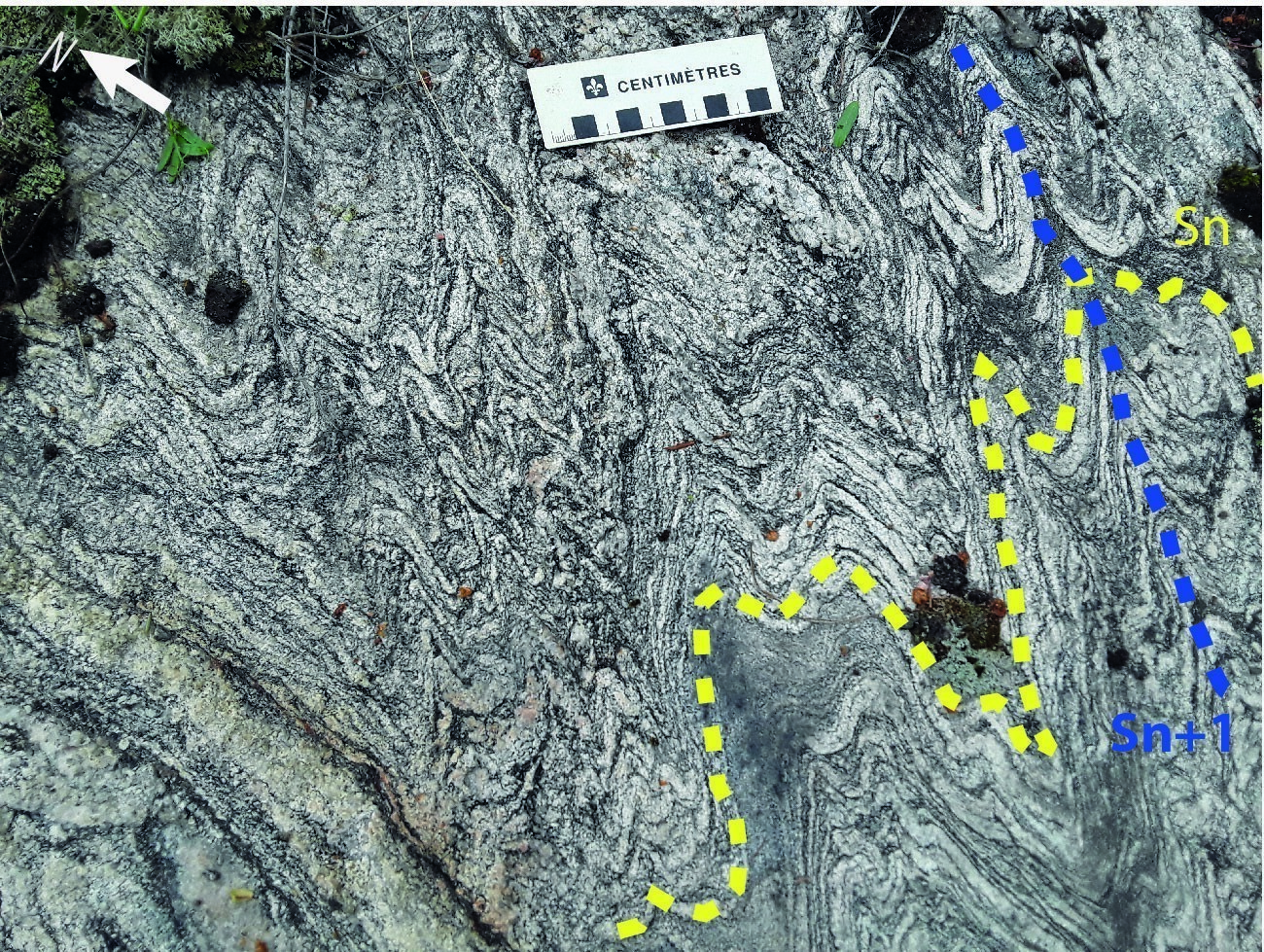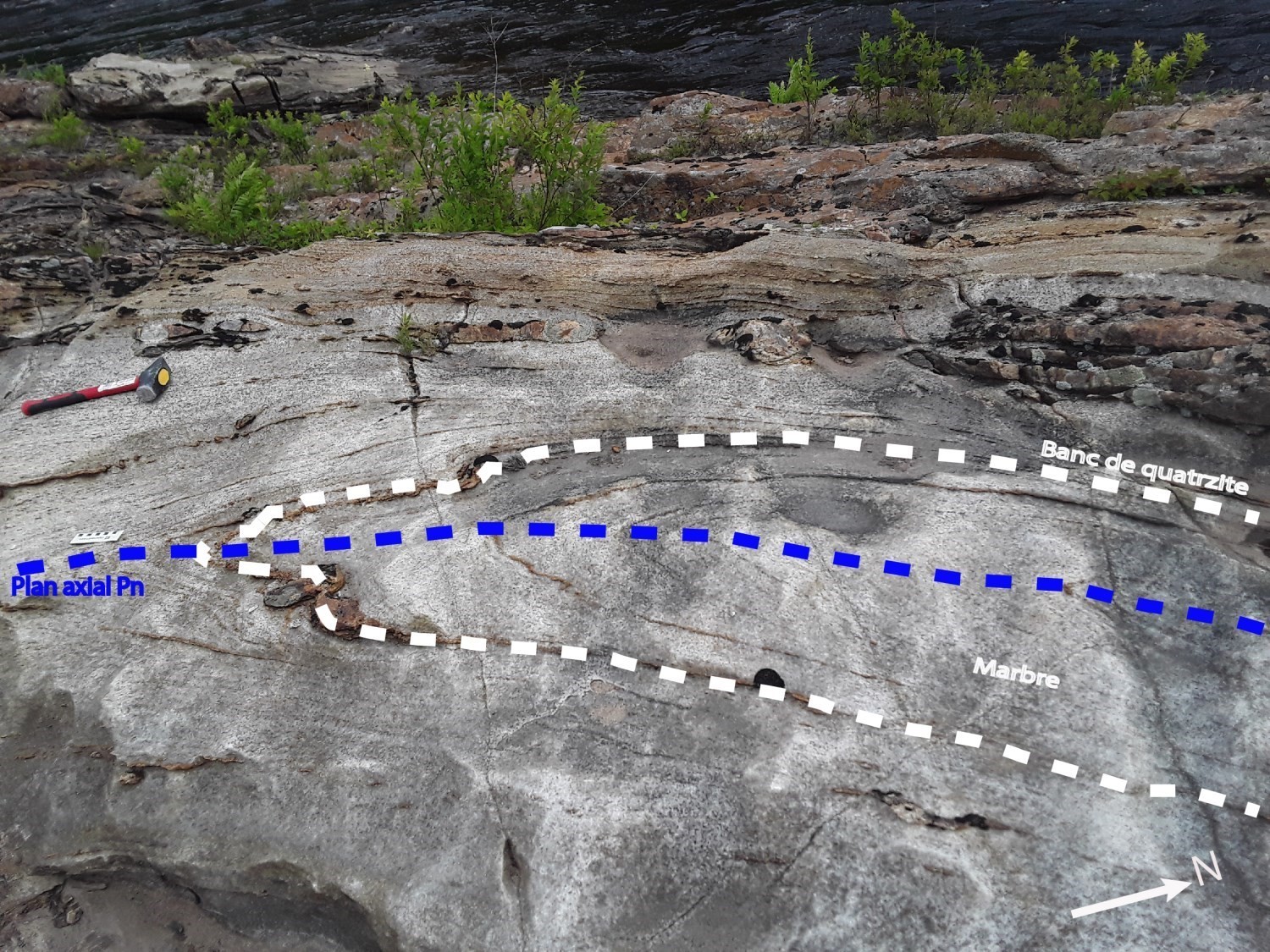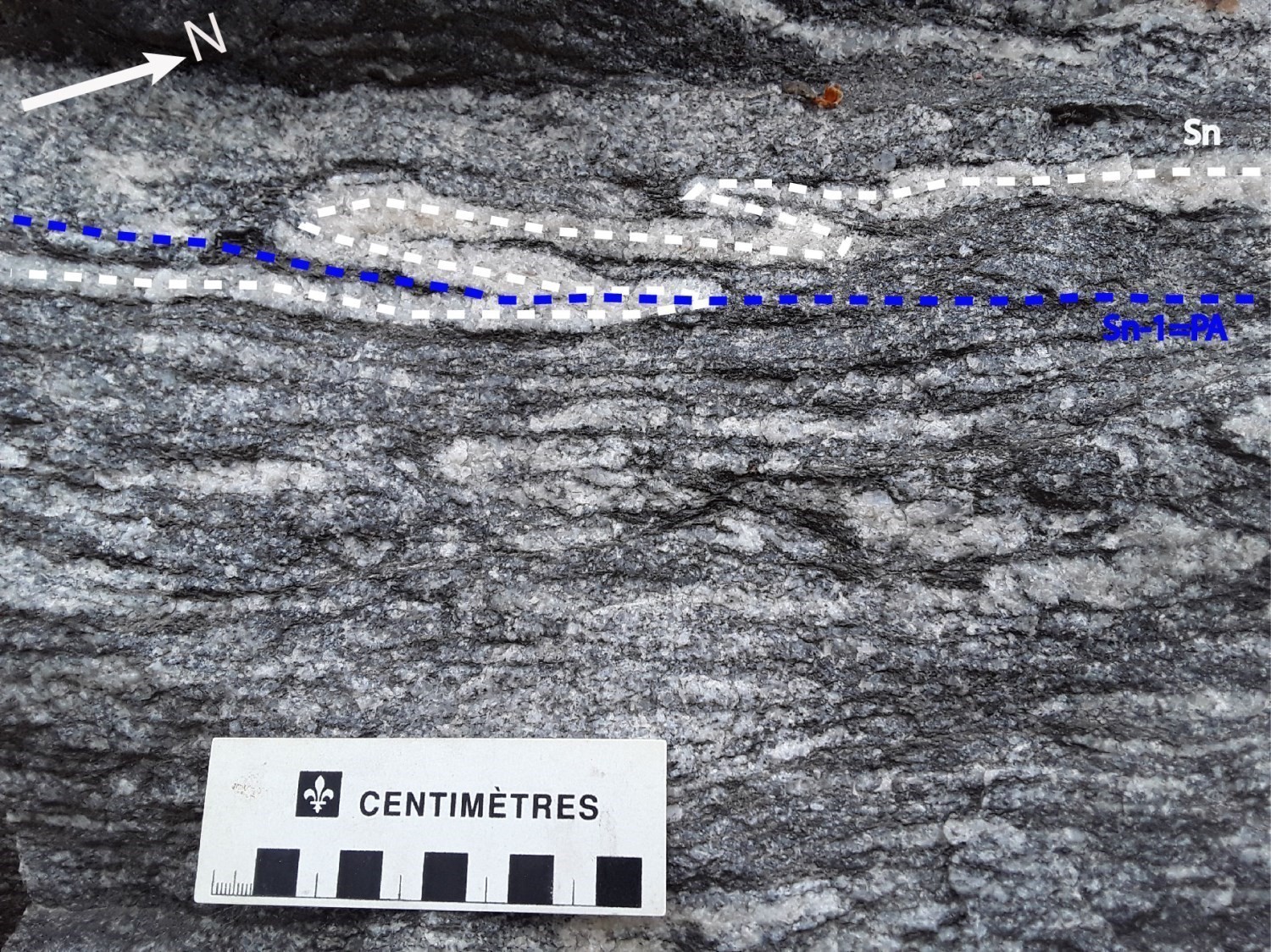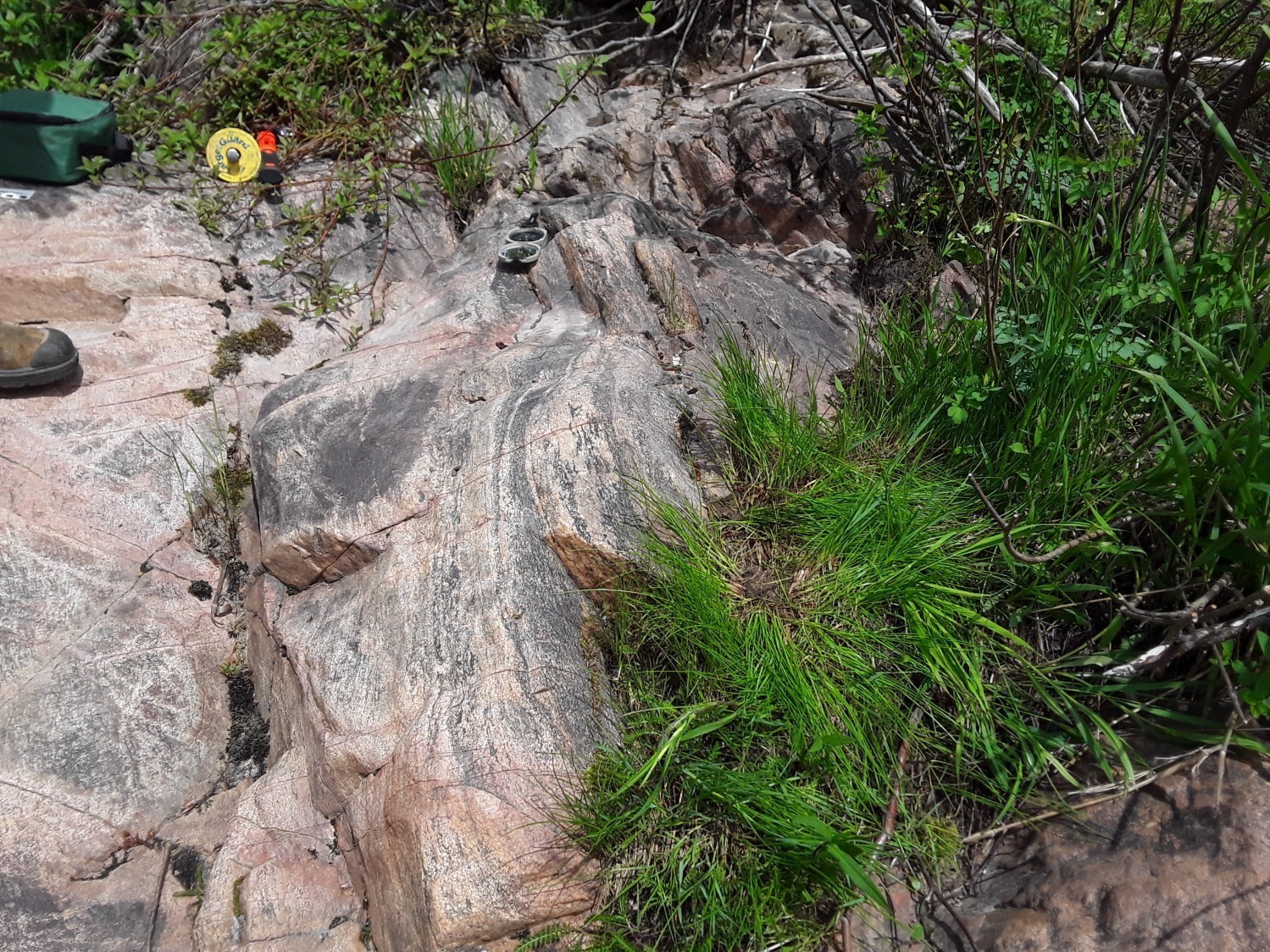
| Author(s) | Moukhsil and El Bourki, 2020 |
| Methodology | Defined from geological survey |
| Geological(s) subdivision(s) | Grenville Province / Allochton |
| Main movement | Does not apply |
| Deformation style | Domes and basins, polyphase folding |
| Metamorphic facies (mean facies related to main deformation) | Granulites |
Background and Methodology
The Patrick Ouest Structural Domain was defined from a geological mapping survey carried out by Moukhsil and El Bourki (2020) in the Normandin area (NTS sheets 32A09 and 32A16).
Boundaries and Morphology
| Width | ~34 km (SSW axis) |
| Length | ~56 km (N-S axis) |
| Orientation | N-S elongation in sheets 32A09 and 32A16 |
The morphology and extent of the Patrick Ouest Structural Domain are not well defined as it appears to be continuous towards the east (sheets 22D12 and 22D13) and towards the north (sheets 32H01 and 22E04). However, the domain is bounded to the west by the Lac Rond Structural Domain (DSrnd) and Sainte-Hedwidge Structural Domain (DShed), and to the south by the Lac-Saint-Jean Structural Domain (DSlsj).
Stratigraphic Units Concerned
Stratigraphic units forming part of the Patrick Ouest Structural Domain are:
- the Lac-Saint-Jean Anorthositic Suite (mPlsj2);
- the Patrick Ouest Charnockite (mPick);
- the Travers Suite (mPtra2);
- the Lachance Mangerite (mPlhc);
- the Sainte-Hedwidge Intrusive Suite (mPshe2 and mPshe1);
- the Saint-Onge Supracrustal Sequence (mPong5, mPong4, mPong3b and mPong2);
- the Claire Gabbronorite (mPclr).
Structural Characteristics
Almost all the outcrops of the Patrick Ouest Structural Domain are located in the NE part of sheet 32A16. They display a planar structural fabric that is expressed mainly by secondary mineral foliation, mylonitic foliation or banding in intrusive rocks, or by gneissosity or migmatitic banding in metasedimentary rocks of the area.
❯ Main Fabrics
The Patrick Ouest Structural Domain is characterized by a fairly homogeneous trajectory of the planar fabric (Sn) in most of the domain’s outcrops. The main direction is NNE-SSW with a mean dip eastward (mean foliation: 024°/47°).
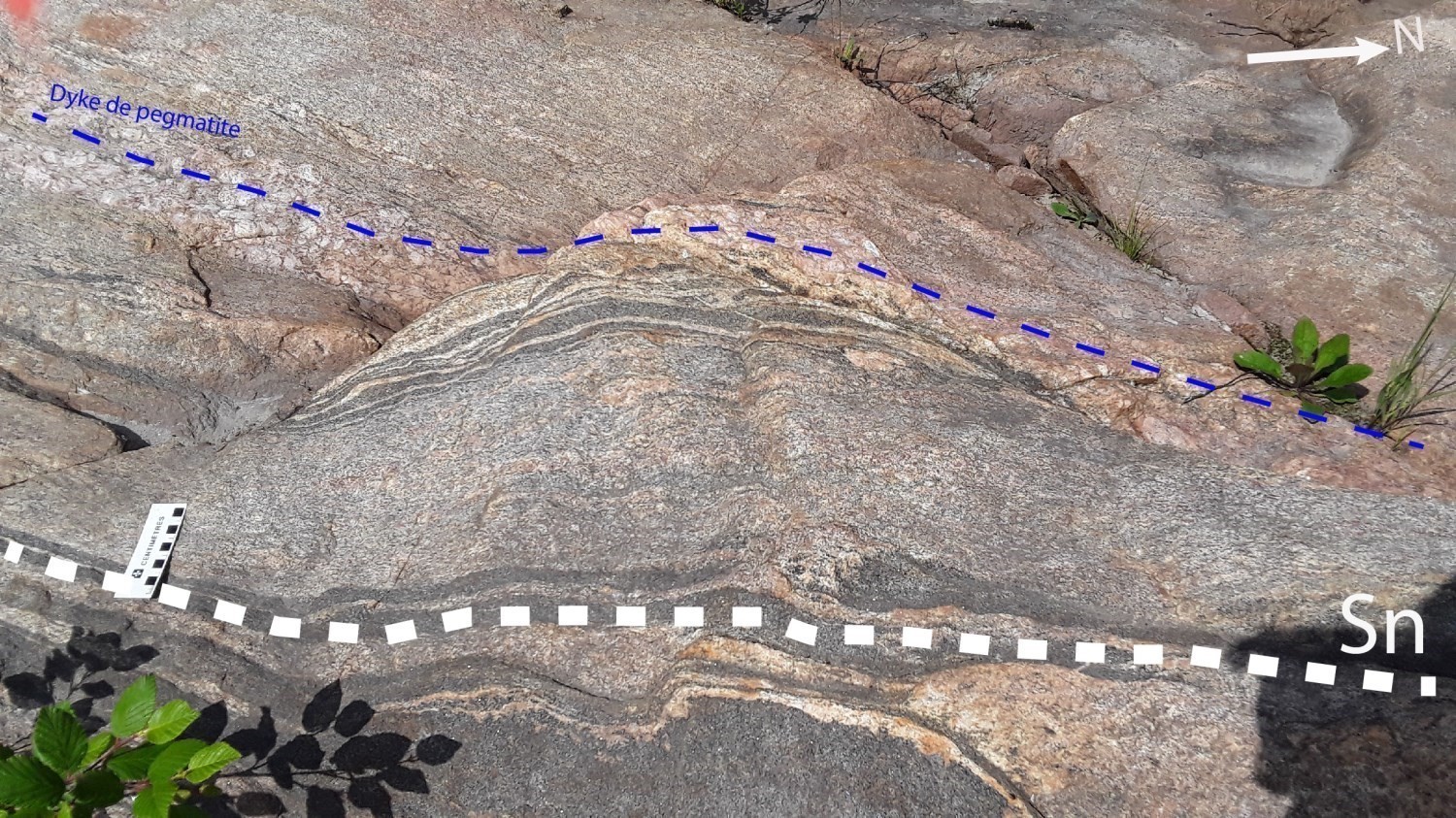 In paragneiss and calcosilicate rocks of the Saint-Onge Supracrustal Sequence, the Sn foliation is marked by a gneissosity characterized by alternating light and dark layers, respectively depleted and enriched in ferromagnesian minerals. In intrusive rocks of the Patrick Ouest Charnockite, SainteHedwidge Intrusive Suite and Lachance Manganite, the main Sn foliation is generally expressed by a secondary tectometamorphic mineral foliation with a preferential orientation of ferromagnesian minerals and, locally, by a preferential orientation of K-feldspar phenocrystals.
In paragneiss and calcosilicate rocks of the Saint-Onge Supracrustal Sequence, the Sn foliation is marked by a gneissosity characterized by alternating light and dark layers, respectively depleted and enriched in ferromagnesian minerals. In intrusive rocks of the Patrick Ouest Charnockite, SainteHedwidge Intrusive Suite and Lachance Manganite, the main Sn foliation is generally expressed by a secondary tectometamorphic mineral foliation with a preferential orientation of ferromagnesian minerals and, locally, by a preferential orientation of K-feldspar phenocrystals.
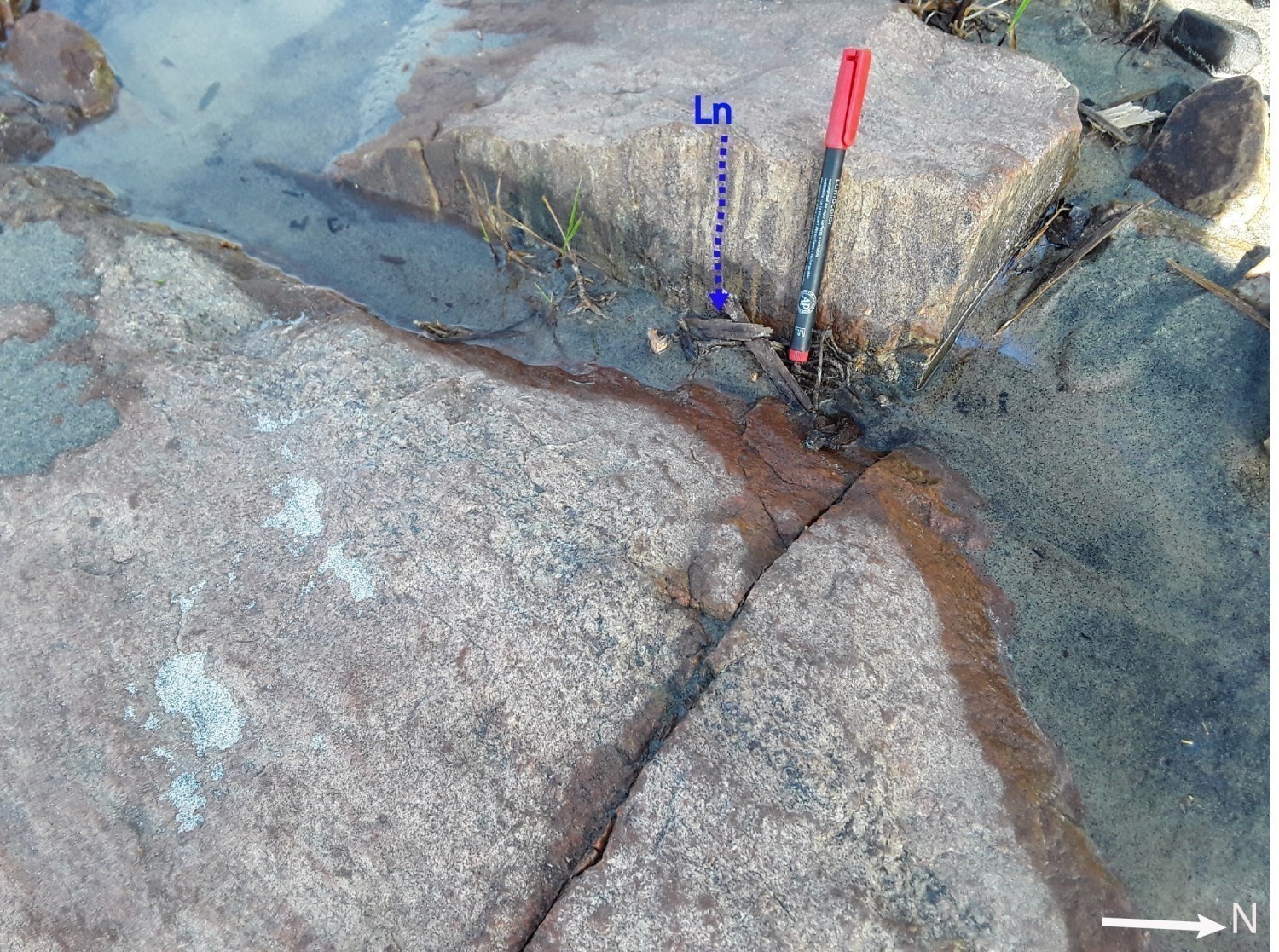 Mineral lineations borne by these planar fabrics are, in general, secondary tectometamorphic mineral or stretch lineations. Their mean direction is 116° with a dip component (mean Ln: 116°/47°).
Mineral lineations borne by these planar fabrics are, in general, secondary tectometamorphic mineral or stretch lineations. Their mean direction is 116° with a dip component (mean Ln: 116°/47°).
| Main Fabric | Type of Fabric | Direction (°) | Dip / Plunge (°) | Number of Measurements | Comments |
| Foliation Sn | Secondary tectonometamorphic mineral foliation, gneissosity, mylonitic foliation or banding, migmatitic banding | 24 | 47 | 83 | Measurements only come from sheet 32A16. |
| Lineation Ln | Secondary tectonometamorphic mineral lineation, stretch lineation | 116 | 47 | 45 |
Most lineations plunge eastward. |
❯ Other Fabricsfabriques
In the Patrick Ouest Structural Domain, some outcrops display a second phase of deformation represented essentially by a tectometamorphic foliation Sn+1. The latter can be easily distinguished from Sn at fold hinges, where it seems to behave like a crenulation foliation with a preferential orientation of ferromagnesian minerals. It is important to note that in this domain, as elsewhere in the area, it is difficult to measure the direction and dip of the Sn+1 foliation since it can easily be confused with Sn.
❯ Folds
The analysis of the distribution of the planar fabric and geophysical lineaments interpreted from maps of the total magnetic field and its derivatives (Intissar and Benahmed, 2015) allow distinguishing at least two families of folding. They are marked by the trajectory of the Sn foliation which affects units of the Patrick Ouest Structural Domain:
The first family is oriented N-S with straight antiforms and synforms observed in the Saint-Onge Supracrustal Sequence (mPong5). The second family, of NE-SW general direction, is characterized by antiforms and synforms overfolded towards the NW in units of the Lachance Mangerite and Travers Suite (mPtra2). Also, this family has a straight attitude in the Saint-Onge Supracrustal Sequence (mPong5). In places, axial planes are subparallel to gneissosity.
Geometric Parameters of Regional Folds:
| Fold or Family of Folds | Type (Anticline, Syncline or Undetermined) | Shape (Antiform or Synform) | Attitude (Overturned or Upright) | Axial Plane | Fold Axis | Position (Certain or Probable) | Deformation Phase | Comments | ||
| Direction | Dip | Direction | Dip | |||||||
| Family of N-S folds | Undetermined | Synform and antiform | Upright | N-S | – | – | – | Certain and probable | – | The N-S family is folded by the NE-SW family. |
| Family of NE-SW folds | Undetermined | Synform and antiform | Upright | NE-SW | ~70 | – | – | Probable | – | |
❯ Crosscutting Relationships
In sheet 32A16, the Patrick Ouest Structural Domain is cut by three families of faults deduced from field observations or maps of the aeromagnetic field and its derivatives (Intissar and Benahmed, 2015).
The NE-SW family is dominant and represented by two major reverse movement faults. The first fault, with an extent of ~15 km, relates the Saint-Onge Supracrustal Sequence (mPong5) to units of the Lachance Mangerite and Sainte-Hedwidge Intrusive Suite (mPshe1 and mPshe2). The second fault, with an extent of ~50 km, separates the Patrick Ouest Charnockite (mPick1) from the Lachance Mangerite (mPlhc), Travers Suite (mPtra2) and Sainte-Hedwidge Intrusive Suite (mPshe1).
The N-S family is represented by a normal fault ~3 km long (outcrop 19-AM-47) and cuts the Sainte-Hedwidge Intrusive Suite (mPshe1).
The NW-SE family comprises nine faults interpreted from maps of the magnetic field and its geophysical derivatives.
Geometric Parameters of Regional Faults Cutting the XYZ Structural Domain:
| Fault or Family of Faults | Type | Mean Direction (°) | Mean Dip (°) | Lineation Plunge in the Fault Plane | Estimated Width (m) | Estimated Length (km) | Apparent Movement | Position | Comments |
| Family of NE-SW faults | Regional faults | NE-SW | ~65 | ~24 | <500? | 15-50 | Sinistral | Certain | – |
| Family of N-S fault | Regional fault | N-S | ~61 | ~40 | <1000? | 3 | Dextral | Certain | – |
| Family of NW-SE fault | Regional faults | NW-SE | ~90 | – | <200? | 3.5-16 | Undetermined | Inferred from geological survey | – |
❯ Kinematics
Does not apply.
Deformation Style
The Patrick Ouest Structural Domain is characterized by polyphase deformation comprising at least two regional folding phases. In general, the Sn foliation marks the early phase of deformation of the domain and is represented by : 1) migmatitic gneissosity or banding in quartzofeldspathic paragneiss and calcosilicate rocks of the Saint-Onge Supracrustal Sequence; 2) secondary tectonometamorphic mineral foliation in intrusive rocks of the Sainte-Hedwidge Intrusive Suite, Lachance Mangerite and Patrick Ouest Charnockite.
The trajectory of the Sn foliation draws upright and overturned synform and antiform folds corresponding to two episodes of deformation. Firstly, Pn+1 represents first generation folds (generally isoclinal, transposed and dismembered) whose axial planes are oriented N-S, which could indicate an E-W compression phase. The second folding episode, Pn+2, is characterized by folds whose axial planes are NE-SW oriented. This episode is probably related to an NW-SE compression phase having slightly curved axial plane traces of the Pn+1 phase.
Metamorphic Characteristics
More than twenty samples representative of lithostratigraphic units of the northern part of the Patrick Ouest Structural Domain (sheet 32A16) were analyzed and studied under a polarizing microscope. The objective was to characterize the type of metamorphism and its distribution in the domain. However, mineralogical assemblages and petrographic characteristics of these samples indicate that metamorphic conditions of this part of the domain mainly reached the granulite facies, including some zones at the upper amphibolite facies. The presence of orthopyroxene reflects temperature conditions typical of the granulite facies with, in general, a coarse grain size and interlobed texture. In places, an assemblage of biotite-hornblende ferromagnesian minerals, without pyroxene, can be observed, which can be explained by retrograde metamorphism from granulite to amphibolite facies.
Alterations
Not observed.
Geophysical Characteristics
The high-resolution total magnetic field map (Intissar and Benahmed, 2015) of sheets 32A09 and 32A16 indicates that the pattern of the Patrick Ouest Structural Domain (DSpko) is quite heterogeneous, including areas with highly contrasted magnetic susceptibility. In the northern part of the domain (sheet 32A16), the magnetic pattern shows an elliptical annular structure in the Lachance Mangerite (mPlhc) and the NE end of the Patrick Ouest Charnockite (mPick1). However, in the Travers Suite (mPtra2) and Saint-Onge Supracrustal Sequence (mPong), the magnetic pattern is characterized by an isotropic banded structure with low magnetic intensity.
Chronological Markers
Higgins and van Breemen (1992) obtained an igneous crystallization age of 1142 ±3 Ma in an undeformed leucogabbro of the Lac-Saint-Jean Anorthositic Suite (sheet 32A16), and van Breemen (2009) obtained an age of 1143 ±2 Ma for the Patrick Ouest Charnockite. As for the Lachance Mangerite, it was dated 1044 ± 6.9 Ma (Papapavlou, 2019). This would mean that the Dn deformation affecting the Patrick Ouest Structural Domain is posterior to 1.04 Ga for the Dn+1 deformation, i.e. it would have occurred after the Middle Grenvillian (1050-1018 Ma), as defined by Gower and Krogh (2002) in the eastern part of the Grenville Province.
References
Publications Available Through Sigéom Examine
INTISSAR, R., BENAHMED, S. 2015. LEVE MAGNETIQUE AEROPORTE DANS LE SECTEUR OUEST DU LAC-ST-JEAN, PROVINCE DE GRENVILLE. MERN, GOLDAK AIRBORNE SURVEYS. DP 2015-06, 7 pages and 2 plans.
MOUKHSIL, A., EL BOURKI, M. 2020. GÉOLOGIE DE LA RÉGION DE NORMANDIN, PROVINCE DE GRENVILLE, RÉGION DU SAGUENAY–LAC-SAINT-JEAN, QUÉBEC, CANADA. MERN. BG 2020-01, 1 plan.
PAPAPAVLOU, K., 2019. U-Pb geochronology report, samples from the Grenville Province (Quebec). GEOTOP UQAM, MERN. Internal report, 17 pages.
VAN BREEMEN, O. 2009. REPORT ON THE U-PB GEOCHRONOLOGY FOR THE PIPMUACAN RESERVOIR REGION. GEOLOGICAL SURVEY OF CANADA. MB 2009-04, 13 pages.
Other publications
GOWER, C.F., KROGH, T.E. 2002. A U-Pb geochronological review of the Proterozoic history of the eastern Grenville Province. Canadaian Journal of Earth Sciences, volume 39, pages 795–829. doi.org/10.1139/e01-090
HIGGINS, M.D., VAN BREEMEN, O. (1992) The age of the Lake St.Jean, Anorthosite Complexe and Associated Mafic Rocks, Grenville Province, Canadian Journal of Earth Sciences; volume 29 (7), pages 1412–1423. doi.org/10.1139/e92-113
Suggested Citation
Ministère de l’Énergie et des Ressources naturelles (MERN), 2020. Patrick Ouest Structural Domain. Quebec Structural Lexicon. https://gq.mines.gouv.qc.ca/lexique-structural/domaine-structural-de-patrick-ouest_en/ [accessed on day month year].
Contributors
|
Première publication |
Abdelali Moukhsil, P. Geo., Ph.D. abdelali.moukhsil@mern.gouv.qc.ca; Mhamed El Bourki, GIT, M.Sc. mhamed.elbourki@mern.gouv.qc.ca (redaction); Ghyslain Roy, P. Geo. (coordination); Fabien Solgadi, P. Geo., Ph.D., (critical review); Simon Auclair, P. Geo., M.Sc. (editing); Ricardo Escobar Moran (HTML editing); Céline Dupuis, P. Geo., Ph.D. (English version) |



